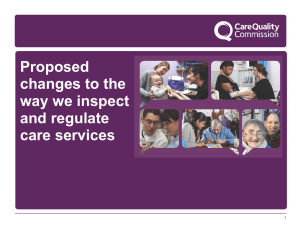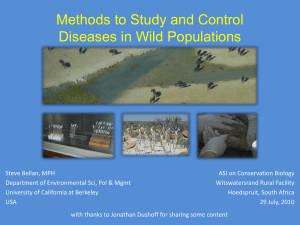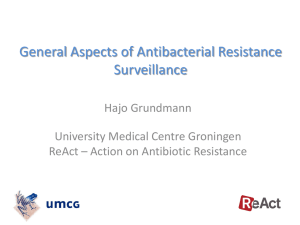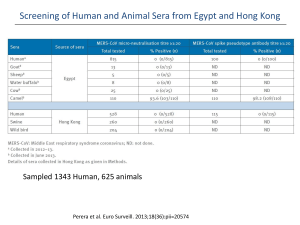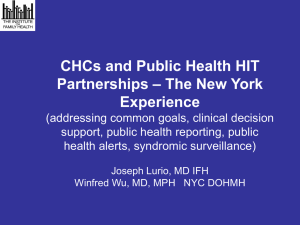Outbreak Investigation and Control
advertisement
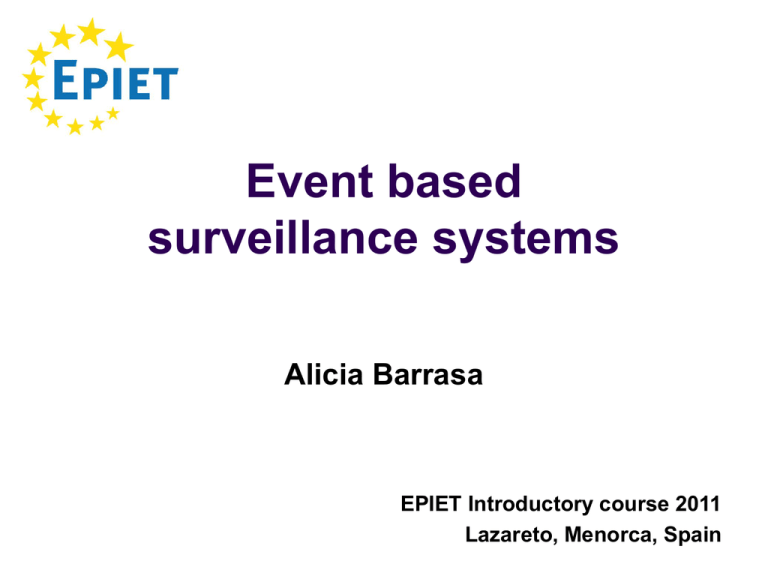
Event based surveillance systems Alicia Barrasa EPIET Introductory course 2011 Lazareto, Menorca, Spain Infectious diseases Arise from many different pathogens: viruses, bacteria, parasites Spread in many different species: humans, insects, domestic and wild animals, aquatic animals and sometimes breach barrier between animal and humans (70% of emerging infections arise from animal population) Take many different routes of transmission: direct contact, vectors, food, environmental Affect all populations in all regions of the world Emerging and Re-emerging infectious diseases Legionnaire’s disease Cryptosporidiosis Shigellosis Human monkepox West Nile Virus E. coli O157 BSE nvCJD Multidrug resistant Salmonella E.coli non-O157 Malaria Typhoid E. coli O157 Rabies SARS Diphtheria West Nile Fever Reston Typhoid Influenza A (H5N1) Kyasanur f. Lassa fever Echinococcosis Nipah Virus Yellow fever Cholera O139 RVF/VHF Reston Virus Venezuelan Buruli ulcer Dengue equine encephalitis O’nyong-nyong haemhorrhagic Respiratory Ebola fever fever infection haemorrhagic Dengue Human haemhorrhagic feverCholera fever Ross monkeypox Hendra River virus Cholera virus Shigellosis Lyme Borreliosis Epidemic Alert and Response (EAR), WHO Regional Office for Europe Accidental and deliberate release of infectious agents • Increased research, biotechnology is widely available • Increased risk for accidental release (e.g. SARS 2004 from laboratory) • World tensions remain and the deliberate release of infectious agents is no longer a remote threat. International Health Regulation 1374 Venice Quarantine for Plague 1851 Paris 1st International Sanitary Conference 1947 Geneva WHO Epidemiological Information Service 1951 Geneva International Sanitary Regulations 1969 Geneva International Health Regulations 2004 Regional consultations Nov 2004 Geneva Intergovernmental Working Group meeting Feb 2005 Geneva Intergovernmental Working Group meeting May 2005 Geneva Revised IHR, World Health Assembly IHR Decision Instrument 4 diseases that always have to be notified polio (wild type virus), smallpox, human influenza caused by a novel virus, SARS. Diseases that always lead to the use of the algorithm : cholera, pneumonique plague, yellow fever, VHF (Ebola, Lassa, Marburg), WNF, meningitis, others *Q1: serious repercussions for public health? Q2: unusual or unexpected? Q3: risk of international spread? Q4: risk of travel or traffic restrictions? Insufficient information : re-evaluate IHR Decision Instrument International Health Regulation - 2005 To decide on need for notification any public health event can be assessed by the criteria • Is the public health impact of the event serious? • Is the event unusual or unexpected? • Is there a significant risk of international spread? • Is there a significant risk of international travel or travel restrictions ? Obligation to establish core capacities: • Surveillance • Response Preparedness and response - ECDC Detection of public health threats related to infectious disease, or of unknown origin Risk assessment, investigation and control Strengthening preparedness of EU member states Strengthening and building capacity through training Provision of technical advice and support to third countries upon request Epidemic Intelligence Definition The systematic collection and collation of information from a variety of sources, usually in real-time, which is then verified and analysed and, if necessary, activates response Objective to speed up detection of potential health threats and allow timely response Epidemic Intelligence Indicator-based surveillance Event-based surveillance “Surveillance” systems Data Events Event monitoring Collect Capture Analyse Filter Interpret Verify Signal Assess Investigate Public health Alert Control measures Disseminate Indicator based Surveillance Surveillance systems Ongoing and systematic Collection and analysis of data Interpretation and dissemination of results related to health events of interest Diagnosis-based or Syndromic surveillance For action Outbreak investigation Immunization programmes Programme planning and evaluation Operational research hypothesis Risk assessments Event based Surveillance Organized and rapid capture of information about events that are a potential risk to public health: • Events related to the occurrence to the disease in humans (clusters, unusual patterns, unexpected deaths…) • Events related to potential exposures (diseases in animals, contaminated food or water, environmental hazards…) Epidemic Intelligence Indicator-based surveillance Event-based surveillance “Surveillance” systems Data Events Event monitoring Collect Capture Analyse Filter Interpret Verify Risk assessment Early warning Signal Assess Investigate Risk Management Public health Alert Control measures Disseminate Response Event based Surveillance Sources of information: • Hospitals/health care centres/emergency rooms • Veterinary services, food agency - West Nile Virus, Rift Valley Fever - Foodborne outbreaks • Meteorological data - Pollution - Heat • Laboratories - Identification of specific pathogens - Increase in demand for hepatitis serology Event based Surveillance Sources of information • Media - systematic searching of news - often in electronic format • International networks Indicator vs event based Indicator based Definitions - Clinical presentation - Characteristics of people - Laboratory criteria - Specific Timeliness - Weekly / monthly (some may be immediate) - Possible delay between identification and notification Event based - ...events that are a potential risk - ...unusual events in the community - Sensitive - All events should be reported to the system immediately - Real time Indicator vs event based Indicator based Event based Actors - Involved in the system - Might not know Reporting structure - Clearly defined - No predefined structure - Reporting forms - Reporting forms flexible for quali and quantitative data - Reporting dates - Teams to analyse data at regular intervals - At any time - Teams to confirm evens and prepare the response Indicator vs event based Indicator based Event based Trigger for action - a pre-defined thresholds - a confirmed event Response - depends on the delay between identification, data collection and analysis - depends on the confirmation of the event, but ideally is immediate A small summary Indicator and event based systems are tools for PH Surveillance Event based systems have already been successfully used The challenge: confirmation of the events Public Health Surveillance during the 2012 Olympic and Paralympic Games Helen Maguire acknowledgements Brian McCloskey, Director, HPS London region Ellen Heinsbroek, EPIET fellow, HPS Colindale London 2012 Olympic and Paralympic Games - 26 Olympic sports in ~34 venues - 20 Paralympic sports in 17 venues - 10,500 Olympic and 4,200 Paralympic athletes - 21,000 media and broadcasters - Over 10.2 million tickets - 180,000 spectators per day in the Olympic Park - 17,000 people living in the Olympic Village What influences our preparations for London 2012? - Politics - Media - Scale Where do we start? What’s been learned before at other mass gatherings? What is the risk assessment? What’s proportionate in relation to the risk? What capability and capacity have we got? What aims /objectives for our surveillance ? Experience of mass gatherings In Atlanta [1996] and in Sydney [2000] infectious diseases accounted for less than 1% of healthcare visits In Beijing …there were no problems .. Experience of mass gatherings Winter Olympic Games, Torino Italy 2006 2 public and private microbiology laboratories provided test results data for Stool culture Hepatitis A serology No difference to non-Olympic period Data reported once a week Experience of mass gatherings Germany World Cup, 2006 Burden of infectious disease did not increase during World Cup Maintenance of daily data transmission in all Federal States Additional free-text reporting for events through usual surveillance system -High sensitivity Syndromic surveillance was regarded as not necessary -as disease surveillance systems already in place London Olympics Surveillance Aim To provide information on selected indicators (including infection related, syndromes, and environmental) as well as on events or incidents that impact on Olympic venues/staff/athletes/visitors -in order to rapidly identify any individual cases or outbreaks /incidents so that interventions can be implemented 30 Objectives 1 review existing systems completeness, sensitivity to unusual events /outbreaks flexibility, timeliness, ability to detect new pathogens 2 identify gaps or limitations 3 enhance existing or establish new systems 31 Enhance existing … Enhance reportable disease by clinicians Enhance laboratory capacity and reporting Enhance environmental monitoring Create 24 on-call and rapid response teams Epidemic Intelligence (existing and new ) 1. Syndromic Surveillance (NHS Direct, Q Surveillance, RCGP, EDSSS, OOH) 2. Notifications of Infectious Diseases 3. Surveillance at Olympic Village Polyclinics 4. Event-Based Surveillance 5. Laboratory Reporting 33 Existing and new surveillance systems Surveillance of Undiagnosed Serious Infectious Illness (USII) Environmental monitoring at Centre for Radiation, Chemical (and Environmental Hazards Mortality Surveillance) 34 1 Syndromic Surveillance Existing systems NHS Direct GP-based syndromic surveillance • Q Surveillance • Royal College General Practitioners New systems Out of Hours Providers Emergency Departments 35 1 Syndromic Surveillance out of hours To provide enhanced surveillance during weekends/holidays/evenings 1 Syndromic Surveillance emergency departments To establish a surveillance network of EDs across England 2 Notifications of infectious diseases Registered Medical Practitioner Normal: fax: max. 3 days Emergency: phone within 24 hrs Proper Officer - Local Authority Max. 3 days (methods differ by LA/HPU) Health Protection Unit Extra requirements Olympics: HPA Colindale: Central Information Management Olympic Venue Attendance • Forms + HPZone to be changed Speed up notifications Report published on internet HPA Colindale: Improve consistency reporting Departments (esp. Immunisation) 38 3. Surveillance at Olympic Village • Requirement to notify infectious diseases compulsory for overseas athletic team doctors • Compulsory component of temporary registration • Same forms as medical practitioners • Notification System being set up • HPA presence in Olympic Polyclinic • Monitoring of staff absences Olympics Surveillance Systems – 3. Surveillance at Olympic Village 39 4. Event based surveillance What is a significant event? Standard factors – e.g. severity, Olympic factors – proximity to venue, affecting visitors The media! How do we identify significant events HPZone – dashboard – flagging events with an ‘Olympic flag’ Regional reporting via teleconference or negative reporting Media screening NOIDS 41 5 Lab reporting Laboratories - Weekly, by law (Oct’10) - Automatic, with manual checking+sending HPU/Region Extra requirements Olympics: HPA Colindale: Central Information Management - Weekly exceedance report published on intranet - Departments access via software HPA Colindale: Daily reporting: software change Automatic extraction software Exceedance Algorithms: daily Adapt for changes in testing, • e.g. multiplex PCR Departments 42 6. Surveillance of Undiagnosed Serious Infectious Illness To ensure early detection and response to new and emerging infectious disease threats. Case definition Any person admitted to HDU/IDU • with a serious illness suggestive of an infectious process where the clinical presentation does not fit with any recognisable clinical picture • OR there is no clinical improvement in response to standard therapy • AND initial laboratory investigations for infectious agents are negative 43 7 Surveillance at Centre for Radiation, Chemical and Environmental Hazards -increase to daily reporting 44 Olympic Surveillance Matrix: Early Detection Surveillance Syndromic System Surv, (NHSD, NOIDS Olympic Q, OOH) Scenario Village Polyclinics UK based surveillance CRCE Laboratory Reporting Syndromic Surveillance – ED *sentinel Localized outbreak, small number of cases e.g. meningococcal * Localized outbreak, large number of cases e.g. measles * USII *sentinel Mortality International Situational Analysis (horizon scanning) Widespread outbreak, small number of cases e.g. food poisoning Widespread outbreak, large number of cases e.g. influenza Increase in weather related disease, e.g. asthma Chemical, Environmental or Radiation incident Imported disease, e.g. plague Newly emerging disease Deliberate release, e.g. anthrax * * * * * 45 289 days to go! 46
